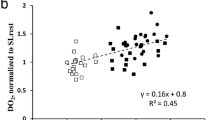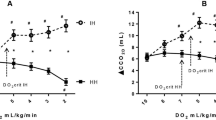Summary
The slope of the CO2-equilibration curve of arterial blood in the pH-logpCO2 diagram,d logpCO2/dpH, was calculated for “in vivo” condition from “in vitro” data assuming that the blood is diluted with interstitial fluid. This theoretical value is always lower than the measured “in vivo” slope. It is suggested that the buffer capacity of intercellular fibers of the connective tissue plays an important role. — The change of the “in vitro” base excess of blood, ΔBE, with “in vivo”pCO2 and respiratory pH, is derived graphically (from the Siggaard-Andersen pH-logpCO2 nomogram) and theoretically. Nonlinear relations are found in all cases. — The influence of additional non-respiratory pH changes on ΔBE is derived graphically. By use of a nomogram the respiratory and the smaller non-respiratory pH effect can clearly be distinguished and ΔBE can be read for any pH-pCO2 pair.
Similar content being viewed by others
References
Albers, C., Ludwig, O., Usinger, W., Spaich, P.: Indirect determination of mean whole body pH and intracellular CO2 and buffer capacity. Respir. Physiol.11, 197–210 (1971)
Altman, Ph. L., Dittmer, D. S.: Blood and other body fluids. Washington D. C.: Federat. Am. Soc. Exp. Biol. 1961
Böning, D.: Veränderungen der CO2-Bildungskurve des Blutes bei akuter respiratorischer Acidose und ihre Ursachen. I. Untersuchungen an Hunden. Pflügers Arch.302, 133–148 (1968)
Böning, D., Heinrich, K. W.: Veränderungen der CO2-Bindungskurve des Blutes bei akuter respiratorischer Acidose und ihre Ursachen. II. Untersuchungen an Menschen. Pflügers Arch.303, 162–172 (1968)
Böning, D., Schweigart, U., Nutz, V., Stegemann, J.: The “in vivo” and “in vitro” CO2-equilibration curves of blood during acute hypercapnia and hypocapnia. I. Experimental investigations. Pflügers Arch.350, 201–212 (1974)
Brackett, N. C., Jr., Cohen, J. J., Schwartz, W. B.: Carbon dioxide titration curve of normal man. Effect of increasing degrees of acute hypercapnia on acid-base equilibrium. New. Engl. J. Med.272, 6–12 (1965)
Cohen, J. J., Brackett, N. C., Jr., Schwartz, W. B.: The nature of the carbon dioxide titration curve in the normal dog. J. clin. Invest.43, 777–786 (1964)
Dell, R. D., Winters, R. W.: A model for the in vivo CO2 equilibration curve. Amer. J. Physiol.219, 37–44 (1970)
Elkinton, J. R., Singer, R. B., Barker, E. S., Clark, J. K.: Effects in man of acute experimental respiratory alkalosis and acidosis on ionic transfers in total body fluids. J. clin. Invest.34, 1671–1690 (1955)
Gauer, O. H., Crone, Ch., Guyton, A. C., Hammersen, F., Laurent, T. C., Zweifach, B. W. (Ed.): Proceedings of a symposium on capillary exchange and the interstitial space. Pflügers Arch.336 Suppl., S1-S98 (1972)
Giebisch, G., Berger, L., Pitts, R. F.: The extrarenal reponse to acute acid-base disturbances of respiratory origin. J. clin. Invest.34, 231–245 (1955)
Haljamäe, H.: Sampling of nanoliter volumes of mammalian subcutaneous tissue fluid and ultra-micro flame photometric analyses of the K and Na concentrations. Acta physiol. scand.78, 1–10 (1970)
Manery, J. F.: Water and electrolyte metabolism. Physiol. Rev.34, 334–417 (1954)
Netter, H.: Theoretische Biochemie. Physikalisch-chemische Grundlagen der Lebensvorgänge. Berlin-Göttingen-Heidelberg: Springer 1959
Roos, A., Thomas, J. L.: The in-vitro and in-vivo carbon dioxide dissociation curves of true plasma: A theoretical analysis. Anesthesiology28, 1048–1063 (1967)
Siggaard-Andersen, O.: The acid-base status of the blood. Copenhagen: Munksgaard 1964
Stern, L. I., Simmons, D. H.: Estimation of nonrespiratory acid-base abnormalities. J. Appl. Physiol.27, 21–24 (1969)
Van Slyke, D. D., Hastings, A. B., Miller, A., Sendroy, J., Jr.: The amounts of alkali bound by serum albumin and globulin. J. biol. Chem.79, 769–780 (1928)
Van Slyke, D. D., Wu, H., McLean, F. C.: Studies of gas and elektrolyte equilibria in the blood. V. Factors controlling the electrolyte and water distribution in the blood. J. biol. Chem.56, 765–849 (1923)
Weber, E.: Grundriß der biologischen Statistik. Stuttgart: Fischer 1967
Author information
Authors and Affiliations
Rights and permissions
About this article
Cite this article
Böning, D. The “in vivo” and “in vitro” CO2-Equilibration curves of blood during acute hypercapnia and hypocapnia. Pflugers Arch. 350, 213–222 (1974). https://doi.org/10.1007/BF00587800
Received:
Issue Date:
DOI: https://doi.org/10.1007/BF00587800




